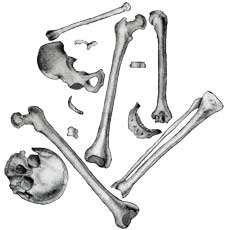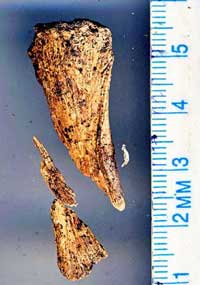 |
Earhart Project Research Bulletin
March 1, 2011
| DNA Research Continues |
There is progress, but as yet no conclusive answer, in TIGHAR’s efforts to determine through DNA analysis whether the castaway of Gardner Island may have been Amelia Earhart.

As detailed in the Earhart DNA Research Update released by Cecil M. Lewis, Jr., Ph.D., of the University of Oklahoma Molecular Anthropology Laboratories, tests of a bone fragment that could conceivably be from Amelia Earhart’s finger are, to date, inconclusive. The bone fragment was found on Nikumaroro, known at the time of Earhart’s 1937 disappearance as Gardner Island, where a large and growing body of circumstantial evidence suggests the missing flyer and her navigator, Fred Noonan, landed and lived for a time as castaways only to eventually perish on the uninhabited, waterless atoll.
 |
 |
 |
 |
| Representation of the bones found by Gallagher in 1940. | Bone fragment found by TIGHAR. | Human skeleton. | Turtle skeleton. |
The archaeological site where the bone fragment was found fits the description of where the partial skeleton of a castaway was discovered in 1940, three years after Earhart disappeared. (For full details of the original bones discovery, see Bones Chronology.) No hand bones were found at that time so the presence of a surviving human finger bone on the site seems plausible. The bone fragment is clearly from an animal that was neither a bird nor a fish, and is structurally finger-like. The only animals known to have been on Nikumaroro that have finger-like bones are humans and sea turtles. Although there were some turtle bones in the area, all were associated with the shell – no limb bones have been identified. As described in Dr. Lewis’ report, initial tests for the presence of human mitochondrial DNA in the bone fragment were positive, but subsequent testing was unable to replicate those results. More general tests for animal DNA were negative. As Dr. Lewis says, at this time it is not possible to make any definitive statements on the bone's origin.
The process of trying to extract DNA is necessarily destructive. Further attempts to resolve the ambiguity, even if successful, would use up the remaining portion of bone, thus precluding any chance for independent replication – an absolutely essential step, especially if the initial tests indicate that the bone is Amelia’s. The same applies to two other bone fragments found at the site in 2010 that might be human. Previous attempts by another lab to extract DNA from those bones were unsuccessful and very little material remains. TIGHAR agrees with Dr. Lewis’ recommendation that further testing on any of the bone fragments should await the development of new technologies and techniques in the rapidly advancing field of DNA research.
 The lab’s analysis of clumps of a substance recovered from the same archaeological site that may be human fecal matter has been more rewarding. The clumps’ physical characteristics were initially examined by University of Maine anthropologist Kristin Sobolik, Ph.D., who has extensive experience in analyzing ancient fecal material. She concluded the mass had some fecal properties and recommended that TIGHAR ask Dr. Lewis to further evaluate the clumps using molecular genetic methods. The University of Oklahoma Molecular Anthropology Laboratories were successful in detecting human mitochondrial DNA in the material. Unlike the bone fragment, the presence of human DNA in the clumps is unambiguous. DNA from two individuals was detected but, to date, the amount extracted is not sufficient for comparison to reference samples. More sophisticated testing is now under way in the hope of learning more.
The lab’s analysis of clumps of a substance recovered from the same archaeological site that may be human fecal matter has been more rewarding. The clumps’ physical characteristics were initially examined by University of Maine anthropologist Kristin Sobolik, Ph.D., who has extensive experience in analyzing ancient fecal material. She concluded the mass had some fecal properties and recommended that TIGHAR ask Dr. Lewis to further evaluate the clumps using molecular genetic methods. The University of Oklahoma Molecular Anthropology Laboratories were successful in detecting human mitochondrial DNA in the material. Unlike the bone fragment, the presence of human DNA in the clumps is unambiguous. DNA from two individuals was detected but, to date, the amount extracted is not sufficient for comparison to reference samples. More sophisticated testing is now under way in the hope of learning more.
It is our hope that sufficient human mitochondrial DNA can eventually be recovered from the bones or other material to compare to the Earhart mitochondrial DNA profile TIGHAR has on file. Meanwhile, analysis of the many artifacts, evidence of meals cooked, and other data collected at the complex archaeological site continues as we plan our next expedition to Nikumaroro now scheduled for the summer of 2012 – the 75th anniversary of the Earhart disappearance.
